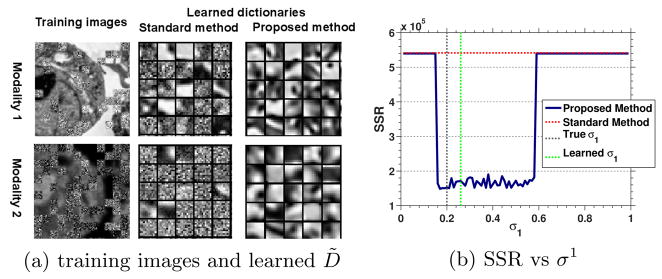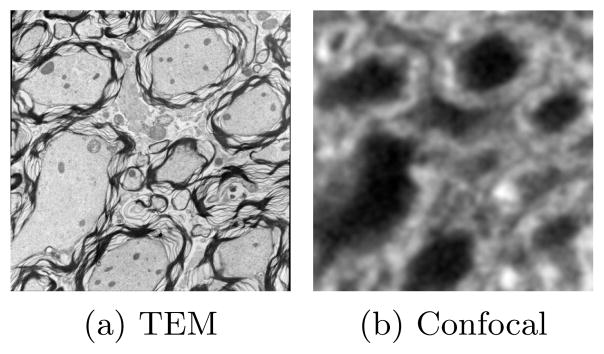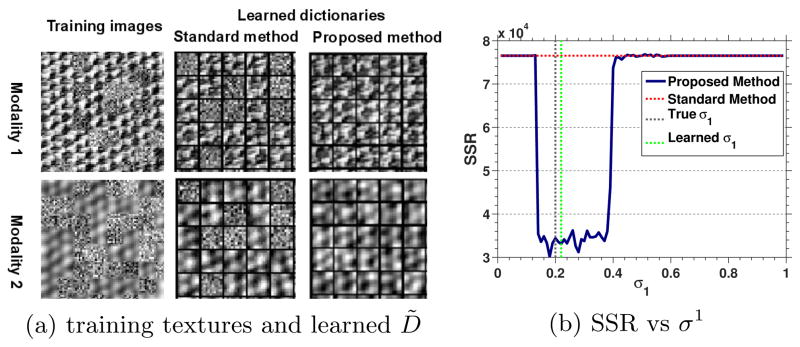Abstract
We propose a robust multimodal dictionary learning method for multimodal images. Joint dictionary learning for both modalities may be impaired by lack of correspondence between image modalities in training data, for example due to areas of low quality in one of the modalities. Dictionaries learned with such non-corresponding data will induce uncertainty about image representation. In this paper, we propose a probabilistic model that accounts for image areas that are poorly corresponding between the image modalities. We cast the problem of learning a dictionary in presence of problematic image patches as a likelihood maximization problem and solve it with a variant of the EM algorithm. Our algorithm iterates identification of poorly corresponding patches and re-finements of the dictionary. We tested our method on synthetic and real data. We show improvements in image prediction quality and alignment accuracy when using the method for multimodal image registration.
1 Introduction
Sparse representation model represents a signal with sparse combinations of items in a dictionary and shows its power in numerous low-level image processing applications such as denoising and inpainting [4] as well as discriminative tasks such as face and object recognition [10]. Dictionary learning plays a key role in applications using sparse models. Hence, many dictionary learning methods have been introduced [1, 11, 6, 7]. In [1], a dictionary is learned for image denoising, while in [6], supervised learning is performed for classification and recognition tasks. In [7], a multimodal dictionary is learned from audio-visual data. Mutltimodal dictionaries can be applied to super-resolution [11], multimodal image registration [3] and tissue synthesis [9].
However, multimodal dictionary learning is challenging: it may fail or provide inferior dictionary quality without sufficient correspondences between modalities in the training data. This problem has so far not been addressed in the literature. For example, a low quality image deteriorated by noise in one modality can hardly match a high quality image in another modality. Furthermore, training images are pre-registered. Resulting registration error may harm image correspondence and hence dictionary learning. Such noise- and correspondence-corrupted dictionaries will consequentially produce inferior results for image reconstruction or prediction. Fig. 1 shows an example of multimodal dictionary learning for both perfect and imperfect corresponding image pairs.
Fig. 1.

An illustration of perfect (left) and imperfect (right) correspondence between multimodal images and their learned dictionaries. The imperfect correspondence (gray part in right images) could result in learning an imperfect dictionary (gray dictionary words) which is not desirable. Our goal is to robustly recover a compact dictionary of corresponding elements.
In this paper, instead of directly learning a multimodal dictionary from training data [3], we distinguish between image regions with and without good correspondence in the learning process. Our main contributions are as follows
We propose a probabilistic model for dictionary learning which discriminates between corresponding and non-corresponding patches. This model is generally applicable to multimodal dictionary learning.
We provide a method robust to noise and mis-correspondences. We demonstrate this using real and synthetic data and obtain “cleaner” dictionaries.
We demonstrate consistency of performance for a wide range of parameter settings. This indicates the practicality of our approach.
The paper is organized as follows: Sec. 2 describes the multimodal dictionary learning method and its probabilistic model. Sec. 3 provides an interpretation of the proposed model. We apply the model to synthetic and real data in Sec 4. The paper concludes with a summary of results and an outlook on future work.
2 Dictionary Learning Method
Let I1 and I2 be two different training images acquired from different modalities for the same area or object. Assume the two images have been registered already.
2.1 Sparse Multimodal Dictionary Learning
To learn a multimodal dictionary D̃ using a sparse representation, one solves
| (1) |
where ||·||1 is the ℓ1 norm of a vector and the ℓ1 regularization induces sparsity in α, N is the number of training samples, D̃ = [D1, D2]T is the corresponding multimodal dictionary (dictionaries are stacked for the two modalities) and x̃i = Ri[I1, I2]T (Ri is an operator to select the ith image patch). Note that there is only one set of coefficients αi per patch, which relates the two dictionaries.
2.2 Confidence Measure for Image Patch
The confidence can be defined as a conditional probability p(h|xi). Given image patches we want to reconstruct them with our learned multimodal dictionary. Here, h is the hypothesis of whether the reconstruction of xi uses some ‘noise’ dictionary items (i.e. non-corresponding dictionary items); h = 1 indicates that the reconstruction xi uses ‘noise’ dictionary elements.
Applying Bayes Rule [8, 2], p(h = 1|xi) can be represented as,
| (2) |
Assuming the independence of each image patch xi and that the pixels in each patch follow a Gaussian distribution, for p(xi|h) we assume
| (3) |
The parameters we need to estimate are θ1 = {μ1, σ1} and θ0 = σ0, as well as the prior probability p(h), where p(h = 1) = π and p(h = 0) = 1 − π.
Based on the assumption of conditional independence of the random variable xi given h and θ [8], we can use either maximum likelihood (ML) or maximum a posteriori (MAP) estimation for these parameters [8].
2.3 Robust Multimodal Dictionary Learning based on EM
For robust multimodal dictionary learning, we want to estimate θ= {D̃, α} considering the latent variable h. Based on the probabilistic framework of dictionary learning [1], we have p(x̃|θ) = Σhp(x̃,h|θ). The ML estimation for θ is as follows
| (4) |
Instead of directly maximizing ℓ(θ), we maximize the lower bound Q(θ) =Σhp(h| x̃, θ) log p(x̃, h| θ) [8]. p(h| x̃, θ) is the confidence in section 2.2. We can apply the following EM algorithm to maximize Q(θ),
In the E-step we compute p(hi| x̃, θ), hi, ∈{1,0}, which provides a confidence level for each training patch given D̃ and α. In the M-step p(hi| x̃, θ) is a weight for each image patch for updating θ. We use a variant of the EM algorithm for multimodal dictionary learning. We replace p(hi|x̃, θ) by δp (p(hi| x̃, θ)). Here, δp (p) is an indicator function and δp (p) = 1, p ≥ 0.5, δp (p) = 0, otherwise. Thus in each iteration we rule out the image patches which have high confidence that they are noise patches. We then refine the multimodal dictionary using the corresponding training samples. The detailed algorithm is shown in Alg. 1.
Algorithm 1.
EM algorithm for Multimodal Dictionary Learning
|
Input: Training multimodal image patches: {x̃i}; i ∈ 1,…,N; Initialize multimodal dictionary D̃ = D̃0, D̃0 is trained on all of the x̃i; | ||
| Output: Refined dictionary | ||
| 1: (E-step) compute δp (p(h=0| x̃i, θ)), where | ||
| ||
| ||
| update θ1 and θ0 in (3) based on δp (p(h=0|x̃i, θ)). | ||
| 2: (M-step) update D̃ and α as follows1, | ||
| ||
| 3: Iterate E and M steps until convergence reached. |
3 Interpreting the Model
If there is no prior information about p(h), we assume p(h = 1) = p(h = 0) = 0.5. If p(h=0|x̃i, θ) > 0.5, based on (3), (5), (6), we have
| (8) |
Here is the sum of squares of reconstruction residuals of image patch x̃i, and is the sum of squares of centered intensity values (with mean μi1 removed) in x̃i.
Thus equation (8) defines the criterion for corresponding multimodal image patches as those patches which can be explained by the multimodal dictionary D̃ better than the patch’s mean intensity, i.e. the sum of squared residuals should be smaller than a threshold T, and T is dependent on the variance of x̃i, , and the variance of the reconstruction residual, .
Intuitively, a small σ1 favors more corresponding image patches and a large σ1 considers more image patches as non-corresponding.
4 Experimental Validation
We consider the image prediction problem (for a known dictionary D̃) solving
| (9) |
Unlike for eq. 1, where x̃i = Ri[I1, I2]T, here where u2 is the prediction of I2. Since I2 is not measured, we can effectively set Riu2 = D2αi or equivalently remove it from the optimization. Given {α̂i} we can then compute the predicted image. Most applications using multimodal dictionary are concerned about the prediction residuals, such as super-resolution and multimodal registration [11, 3]. We therefore first validate our algorithm based on the resulting sum of squares of prediction residuals (SSR).
We test our proposed multimodal dictionary learning method on synthetic and real data. For the synthetic data, we generate non-corresponding multimodal image patches using the following generative model. We choose p(h = 1) which defines the noise level in the training set, i.e. the percentage of non-corresponding multimodal image patches in the training set. For each non-corresponding patch we generate μi1 as the mean of all training patches and add Gaussian noise εμ. We generate a noise patch by adding Gaussian noise to the mean μi1.
4.1 Synthetic Experiment on Textures
We create multimodal textures by smoothing a given texture with a Gaussian kernel and inverting the intensity of the smoothed image. Fig. 2 shows an example of our generated multimodal textures. We generate both training and testing multimodal textures from Fig. 2, i.e. use half of the multimodal textures for training (add noise as non-correspondence regions) and the other half of the multimodal textures for testing. We extract 10×10 image patches in both training images, and add ‘noise’ with non-corresponding image patches to replace corresponding patches. The σ for the Gaussian noise is set to 0.2.
Fig. 2.
D̃ is learned from training images with Gaussian noise (left). Standard method cannot distinguish corresponding patches and non-corresponding patches while our proposed method can remove non-corresponding patches in the dictionary learning process. The curve (right) shows the robustness with respect to σ1. The vertical green dashed line indicates the learned σ1.
We test how σ1 influences our dictionary learning method at a fixed noise level p(h = 1) = 0.5. Fig. 2 shows the result. In practice, we can either learn σ1 with an EM algorithm or manually choose it. When σ1 is close to 0.2 (the σ for the noise), to be specific, σ1 ∈ (0.15, 0.4), we get consistently lower SSRs. This indicates that our algorithm is robust for a wide range of σ1 values and noise. For σ1 < 0.15, all the patches are considered as corresponding patches while for σ1 > 0.4, all the patches are classified as non-corresponding patches. Our method has the same performance as the standard method in [3] in these two cases. The learned multimodal dictionaries are illustrated in Fig. 2 showing that our algorithm successfully removes non-corresponding patches.
4.2 Synthetic Experiment on Multimodal Microscope Images
We also test the proposed algorithm on correlative microscope images. We have 8 pairs of Scanning Electron Microscopy (SEM) and confocal images. Image pairs have been aligned with fiducials. Fig. 3 (a) illustrates an example of SEM/confocal images. We add non-corresponding patches using the same method as in sec. 4.1. Fig 3 (a) shows the results. The dictionary learned with our method shows better structure and less noise compared with the standard dictionary learning method. Fig. 3 (b) shows the interaction between σ1 and SSR with fixed p(h = 1) = 0.5. For σ1 < 0.16, all the image patches are categorized as corresponding patches while for σ1 > 0.6, all the patches are classified as non-corresponding patches. Our method has the same performance as the standard method under these conditions. We observe a large range of σ1 values resulting in improved reconstruction results indicating robustness.
Fig. 3.

D̃ is learned from training SEM/confocal images with Gaussian noise (left). The curve (right) shows the robustness with respect to σ1. The vertical green dashed line indicates the learned σ1.
4.3 Multimodal Registration on Correlative Microscopy
We use the proposed multimodal dictionary learning algorithm for multimodal registration [3]. The multimodal image registration problem simplifies to a monomodal one using the multimodal dictionary in a sparse representation framework. The test data is Transmission Electron Microscopy (TEM) and confocal microscopy. We have six pairs of TEM/confocal images. We train the multimodal dictionary using leave-one-out cross-validation. Fig. 4 shows an example of our test data. We first registered the training images with manually chosen landmarks (no ground truth available), then learned the multimodal dictionary and applied it to predict the corresponding image for a given source image. We resampled the predicted images with up to ± 2.07μm (30 pixels) in translation in the x and y directions (at steps of 10 pixels) and ± 20° in rotation (at steps of 10 degrees). Then we registered the resampled predicted image to the corresponding target using a rigid transformation model. σ1 is chosen as 0.15 based on cross-validation for the prediction errors in this experiment. Tab. 1 shows a comparison of our method with the method in [3]. The result shows about 15% improvement in prediction error and a statistically significant improvement in registration errors.
Fig. 4.

TEM/Confocal images
Table 1.
Prediction and registration results. Prediction is based on the method in [3], and we use SSR to evaluate the prediction results. Here, MD denotes our proposed multimodal dictionary learning method and ST denotes the dictionary learning method in [3]. The registrations use Sum of Squared Differences (SSD) and mutual information (MI) similarity measures. We report the results of mean and standard deviation of the absolute error of corresponding landmarks in micron (0.069 micron = 1 pixel). The p-value is computed using a paired t-test.
| Metric | Method | mean | std | p-value | |
|---|---|---|---|---|---|
| Prediction | SSR | MD | 6.28 × 104 | 3.61 × 103 | |
| ST | 7.43 × 104 | 4.72 × 103 | |||
|
| |||||
| Registration | SSD | MD | 0.760 | 0.124 | 0.0004 |
| ST | 0.801 | 0.139 | |||
| MI | MD | 0.754 | 0.127 | 0.0005 | |
| ST | 0.795 | 0.140 | |||
5 Conclusion
In this paper, we proposed a robust multimodal dictionary learning method based on a probabilistic formulation. We directly model corresponding and non-corresponding multimodal training patches. Our method is based on a variant of the EM algorithm which classifies the non-corresponding image patches and updates the multimodal dictionary iteratively. We validated our method using synthetic and real data. Our algorithm demonstrated its robustness to noise (non-corresponding image patches). We also applied our method to multimodal registration showing an improvement in alignment accuracy compared with the traditional dictionary learning method. The proposed method is expected to be of general use for multimodal dictionary learning. While our method is based on a Gaussian noise model, it can easily be adapted to other noise model such as Poisson noise. Future work will address multimodal dictionary learning in the context of deformable image registration.
Acknowledgments
This work was supported by NSF (EECS-1148870, EECS-0925875), NIH (5P41EB002025-28, 5R01GM097587-03, 2P41EB002025-26A1), Delaware INBRE program (NIH NIGMS 8P20GM103446-13) and Lineberger Comprehensive Cancer Center startup funds.
Footnotes
We use SPAMS (http://spams-devel.gforge.inria.fr) for dictionary learning and sparse coding[5].
References
- 1.Aharon M, Elad M, Bruckstein A. K-svd: An algorithm for designing overcomplete dictionaries for sparse representation. Signal Processing, IEEE Transactions on. 2006;54(11):4311–4322. [Google Scholar]
- 2.Besag J. On the statistical analysis of dirty pictures. Journal of the Royal Statistical Society. Series B (Methodological) 1986:259–302. [Google Scholar]
- 3.Cao T, Zach C, Modla S, Powell D, Czymmek K, Niethammer M. Registration for correlative microscopy using image analogies. Biomedical Image Registration. 2012:296–306. doi: 10.1016/j.media.2013.12.005. [DOI] [PMC free article] [PubMed] [Google Scholar]
- 4.Elad M, Aharon M. Image denoising via sparse and redundant representations over learned dictionaries. Image Processing, IEEE Transactions on. 2006;15(12):3736– 3745. doi: 10.1109/tip.2006.881969. [DOI] [PubMed] [Google Scholar]
- 5.Mairal J, Bach F, Ponce J, Sapiro G. Online dictionary learning for sparse coding. Proceedings of the 26th Annual International Conference on Machine Learning; ACM. 2009. pp. 689–696. [Google Scholar]
- 6.Mairal J, Bach F, Ponce J, Sapiro G, Zisserman A. Supervised dictionary learning. NIPS. 2008:1033–1040. [Google Scholar]
- 7.Monaci G, Jost P, Vandergheynst P, Mailhe B, Lesage S, Gribonval R. Learning multimodal dictionaries. Image Processing, IEEE Transactions on. 2007;16(9):2272–2283. doi: 10.1109/tip.2007.901813. [DOI] [PubMed] [Google Scholar]
- 8.Neal R, Hinton G. A view of the em algorithm that justifies incremental, sparse, and other variants. NATO ASI Series D Behavioural and Social Sciences. 1998;89:355– 370. [Google Scholar]
- 9.Roy S, Carass A, Prince J. Information Processing in Medical Imaging. Springer; 2011. A compressed sensing approach for mr tissue contrast synthesis; pp. 371–383. [DOI] [PMC free article] [PubMed] [Google Scholar]
- 10.Wright J, Yang A, Ganesh A, Sastry S, Ma Y. Robust face recognition via sparse representation. Pattern Analysis and Machine Intelligence, IEEE Transactions on. 2009;31(2):210–227. doi: 10.1109/TPAMI.2008.79. [DOI] [PubMed] [Google Scholar]
- 11.Yang J, Wright J, Huang T, Ma Y. Image super-resolution via sparse representation. Image Processing, IEEE Transactions on. 2010;19(11):2861–2873. doi: 10.1109/TIP.2010.2050625. [DOI] [PubMed] [Google Scholar]



